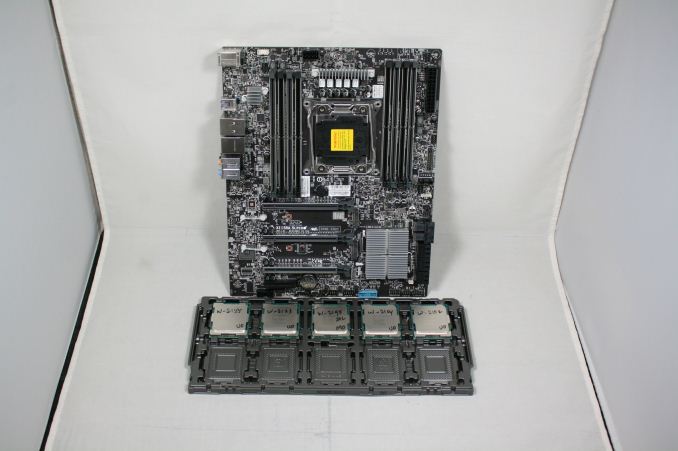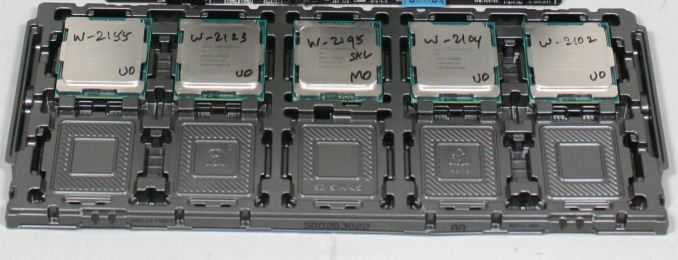The Intel Xeon W Review: W-2195, W-2155, W-2123, W-2104 and W-2102 Tested
by Ian Cutress & Joe Shields on July 30, 2018 1:00 PM EST- Posted in
- CPUs
- Intel
- Xeon
- Workstation
- ECC
- Skylake-SP
- Skylake-X
- Xeon-W
- Xeon Scalable
Conclusion: Is Intel Serious About Xeon W?
In this review, we have covered the performance on three of the more popular Xeon W processors, as well as two off-roadmap parts, and discussed that the Intel’s decision to bifurcate the way its workstation and consumer processors work has put more questions on the table for prospective buyers.
This ultimately comes down to the question: Is Intel Serious About Xeon W? If we ask Intel about this, of course the answer to them is yes – they want to have target markets and have a product portfolio that they feel will fit with that user base. However I am not so sure.
Xeon W was launched a lot later than both the Xeon Scalable platform and the equivalent Skylake-X consumer platform. The messaging behind Xeon W is unclear to a large degree, with only a limited amount of PR invested into it, unlike Xeon Scalable or Skylake-X. The decision to split the market between consumer and workstation, despite having a common socket, has minimized the accessibility of the workstation platform: fewer discussions are being had about the hardware, because there’s little room for a truly mix-and-match scenario as with previous generations. At no point in Intel’s messaging were we offered review samples for example, which is usually an indication that the product line is not one that the product managers are looking to promote. Only Intel’s latest Xeon E designs, released 10 months after the first equivalent consumer parts, beats Xeon W in terms of how un-exciting it can be to try and discuss talking about a platform. Intel does not want to sample Xeon E, either.
So will Intel lose workstation market share to AMD? If I am being so pallid, what are the financial ramifications for this market? AMD’s Threadripper looks like an appealing platform for workstation users for sure, but AMD is not without its own issues. Intel is the incumbent, and has embedded itself with a large number of OEMs and end-users for years, making it difficult for AMD to break that market. AMD’s chiplet design will take a few generations to get used to, so users might stick with ‘what they know’, regardless of any cost/benefit analysis. There is also the discussion of ECC support on Threadripper, for which the messaging has been somewhat unclear: technically it should support up to ECC LRDIMMs, however it does depend a lot on whether the motherboard vendor has qualified their product for RDIMMs or LRDIMMs – most of them are not, complicating the issue. If AMD wanted to tackle this space, they need an ASUS or a GIGABYTE to build a ‘workstation focused’ motherboard, with confirmed ECC and co-processor support. GIGABYTE’s Designare line and MSI’s upcoming X399 Creation might be aimed at this, but it really does require a razor-sharp message to get through.
All this confusion means that while AMD can be competitive in most tests, Intel is expected to remain the market leader for the foreseeable future.
I’m Sold on Xeon W: Tell Me About Performance
As our benchmarks are anything to go by, there is a lot of parity in performance between Intel’s Xeon W and Intel’s Skylake-X product lines. Xeon W takes a hit in memory workloads, because of the memory support: ECC RDIMMs are typically run at base JEDEC sub-timings, and so our DDR4-2666 memory was run at 19-19-19, compared to the 16-16-17 on the consumer platform which is more typical.
Our Xeon W results are skewed a bit towards the low-end processors, mostly because three of the five units we managed to acquire were quad-core processors. At this level, Intel’s now EOL Kaby Lake-X processors fared better, or the consumer Coffee Lake-S look like the better option, unless the user needs ECC or more PCIe lanes than the consumer products provide. The obvious counterpoint here is that if a user needs ECC, and is happy with 64 GB maximum memory support, then Intel’s own Xeon E is also an option, however we have not tested those parts yet (if any OEM can sample them to us, please let us know).
On the high-end, we do see the W-2195 sit behind the Core i9-7980XE in almost all benchmarks, which also means that for embarrassingly parallel workloads, it also sits behind the Threadripper 1950X. It still holds that Intel’s single threaded performance of the Xeon W, despite the lack of Turbo Boost 3.0, still gives it a significant advantage in single threaded workloads over AMD.
For users worrying about Spectre and Meltdown patches affecting performance, in our SYSMark tests we saw a 2-6% decrease over all the tests, with the hardest hit tests seeing a 12% decrease due to the correlation with storage.
Why Buy Xeon W?
The obvious reasons to buy Xeon W processors are just tick boxes: ECC memory, PCIe lanes, co-processor verification. If these are needed, the number of options for the rest of the system (particularly the motherboard) becomes slim, especially when factoring in price and total cost of ownership. A lot of the workstation market works on development cycles and high-throughput compute: the faster the compute, the quicker the prototyping. The fastest processors for a lot of that work, if CPU bound, are won by the consumer Core i9 or Threadripper, however if the above boxes are ticked, then Xeon W would be needed. Or Xeon Scalable, depending on budget.
A small side note to end: If anyone has access to any of the Apple-only Xeons (like the W-2150B) and would kindly let us borrow it for a review, please let me know over email.












74 Comments
View All Comments
Alsw - Monday, July 30, 2018 - link
Nice article, unless i missed it it would be really handy to know all core Turbo boosts you acheived as i don't' think Intel release this info any more? i am in a situation where our FEA/CFD applications beneifit from both frequency and GHz so it is tricky, even before you start taking into acount whether dual CPU is better with the potential for performance variance data being passed between two physical CPU'sIan Cutress - Monday, July 30, 2018 - link
I thought I had the information, but I do not. I've reached out to Intel - normally the enterprise side of the business gives out this info, but the consumer side does not. I'll update the review when we get the details.eek2121 - Monday, July 30, 2018 - link
Looks like it's time to update your benchmark suite and redo benchmarks. Octane 2.0 has long since been retired, WebXPRT 15 as well. I like chrome, but you can disable updates in Firefox fairly easily. 7zip is at (!) 18.05. The version you are using is from 2010.Ian Cutress - Monday, July 30, 2018 - link
We've got a new benchmark suite for our next review, I put the finishing touches to it recently. The time we had these CPUs, it was not ready in time (also for retesting - a new suite takes about a month to bed in with older hardware).HStewart - Monday, July 30, 2018 - link
Ian, it would be really nice to see the performance benefits of AVX 512 in these benchmarks.I try to search for what applications are available that use AVX 512 - only thing I found was the following
https://www.hpcwire.com/2017/06/29/reinders-avx-51...
Ian Cutress - Monday, July 30, 2018 - link
I've got a few for our new suite. 3DPM has an AVX-512 mode now, and I've got the latest y-cruncherJoeyJoJo123 - Monday, July 30, 2018 - link
"AMD’s chiplet design will take a few generations to get used to"Is chiplet the silicon equivalent of calling someone a manlet? Lol.
jcc5169 - Monday, July 30, 2018 - link
There they go again! More Intel Fanboy propaganda !!!Ian Cutress - Monday, July 30, 2018 - link
So a review of a product = fan boy? What? Last week I was told I was an AMD shill.BurntMyBacon - Tuesday, July 31, 2018 - link
CONFIRMED! Ian is a double agent. Now that his cover is blown, he must commence emergency extraction procedures and call in a body double.Or maybe people just get a little too upset when things don't go as expected ..... Nah, I like the double agent story better. You'll have to let us know what your call signs were.